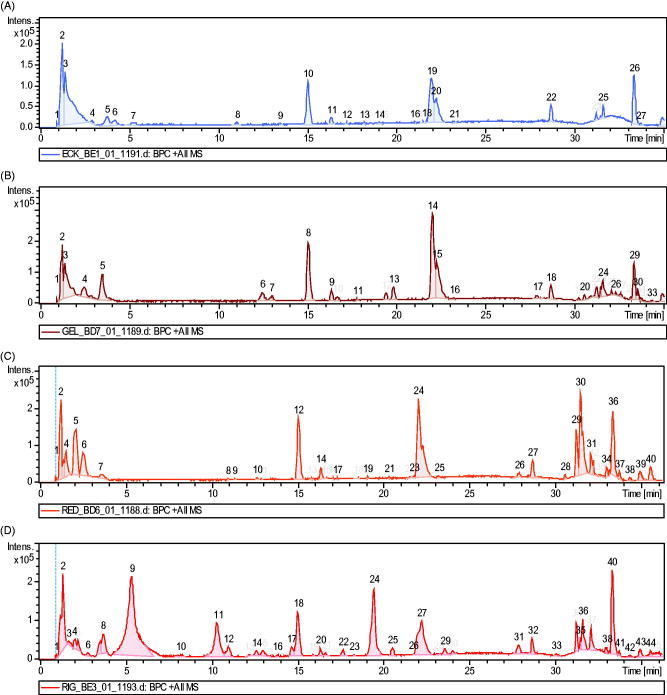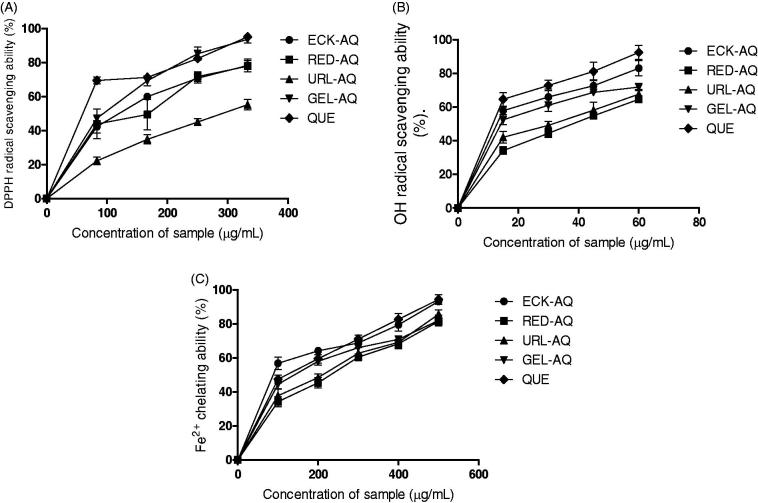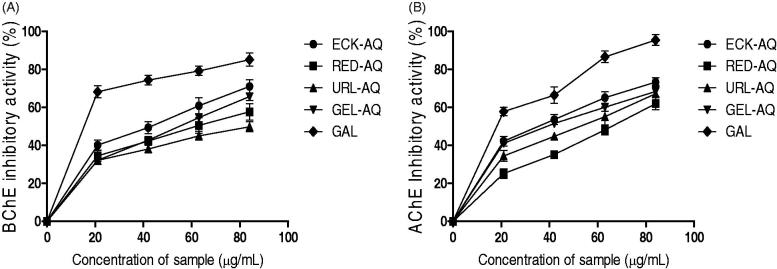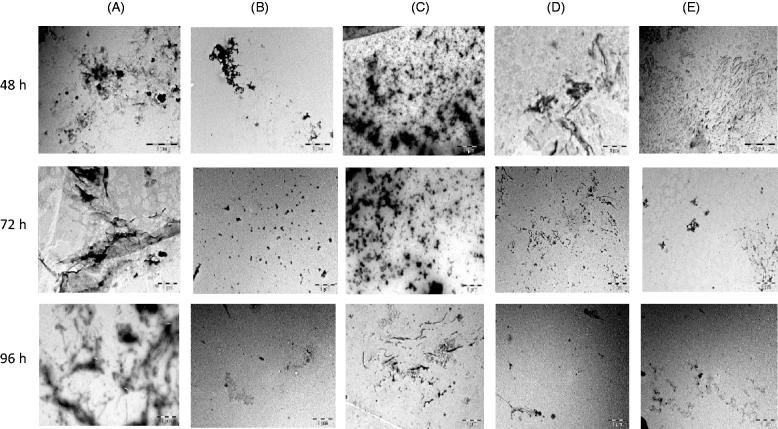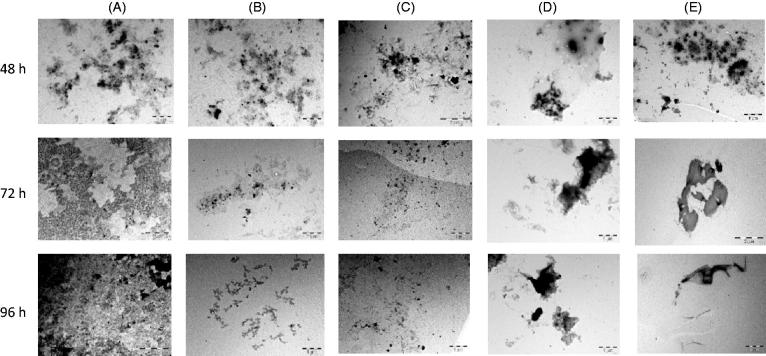Abstract
Context: Seaweeds contain bioactive compounds with different biological activities. They are used as functional ingredients for the development of therapeutic agents to combat degenerative diseases.
Objective: This study investigated the phenolic composition, antioxidant activity, cholinesterase inhibitory and anti-amyloidogenic activities of aqueous extracts of Gracilaria beckeri (J.Agardh) Papenfuss (Gracilariaceae) (RED-AQ), Ecklonia maxima (Osbeck) Papenfuss (Lessoniaceae) (ECK-AQ), Ulva rigida (C.Agardh) Linnaeus (Ulvaceae) (URL-AQ) and Gelidium pristoides (Turner) Kützing (Gelidiaceae) (GEL-AQ).
Materials and methods: Phenolic composition of the seaweed extracts was determined using liquid chromatography mass spectrometry. Radical scavenging and metal chelating activities were assessed in vitro. The effect of the extracts (21–84 µg/mL) on acetylcholinesterase and butyrylcholinesterase activities were also investigated using an in vitro colorimetric assay. Transmission electron microscope and thioflavin-T fluorescence assay were used to examine the anti-amyloidogenic activities of the extracts.
Results: Phloroglucinol, catechin, epicatechin 3-glucoside were identified in the extracts. ECK-AQ (IC50=30.42 and 280.47 µg/mL) exhibited the highest OH• scavenging and metal chelating activities, while RED-AQ (41.23 and 334.45 µg/mL) exhibited the lowest. Similarly, ECK-AQ (IC50 = 49.41 and 52.11 µg/mL) exhibited higher inhibitory effects on acetylcholinesterase and butyrylcholinesterase activities, while RED-AQ (64.56 and 63.03 µg/mL) showed the least activities. Rapid formation of β-amyloid (Aβ1-42) fibrils and aggregates was observed in electron micrographs of the control after 72 and 96 h. The reduction of Aβ1-42 aggregates occurred after co-treatment with the seaweed extracts.
Discussion and conclusion: ECK-AQ, GEL-AQ, URL-AQ and RED-AQ may possess neuroprotective potential and could be explored for the management of Alzheimer’s disease.
Keywords: Alzheimer’s disease, cholinesterases, β-amyloid peptide
Introduction
Alzheimer’s disease is a neurological disorder which affects millions of aged individuals across the world (Li et al. 2018). It is the most common kind of dementia that is characterized by redox imbalance in the neurons, cholinergic deficit, formation of neurotoxic amyloid senile plaques, neuroinflammation and neurodegeneration which leads to cognitive decline, learning problems and memory loss (Feng and Wang 2012; Mendiola-Precoma et al. 2016). Although the pathogenesis of AD is complex, development of this neurological disease has been linked with impaired cholinergic pathway which is caused by upregulation of acetylcholinesterase and butyrylcholinesterase as well as rapid depletion of acetylcholine (Adefegha et al. 2016; Ferreira-Vieira et al. 2016). The disruption in the amyloid precursor protein processing pathway has been identified as one of the pathological hallmarks of AD (Singh et al. 2016). Elevated concentrations and/or activity of the β-site amyloid precursor protein-cleaving enzyme in brain cells trigger the formation of β-amyloid peptides which accumulates and aggregate to form senile plaques around the neurons (O'Brien and Wong 2011; Olasehinde, Odjadjare, et al. 2019) . The senile plaques consist of peptides alongside with redox metals such as Zn, Fe2+ or Cu which are capable of initiating the production of free radicals and redox imbalance in the neurons (Cheignon et al. 2018). Some of the free radicals produced such as hydroxyl radicals are able to induce oxidative damage to the neurons which leads to cell death and ultimately progression of AD (Olasehinde et al. 2017; Oboh, Ademosun, et al. 2018a). Though cholinesterase inhibitors such as galathanmine, rivastigmine and prostigmine are preferred drugs used for the management of AD, these drugs are able to mitigate cholinergic deficit and cannot prevent or halt the progression of AD. Furthermore, β-amyloid aggregation inhibitors and clearance activators are still under clinical trials. Hence, there has been a great interest in the search for an alternative therapeutic approach for the treatment and/or management of AD.
Seaweeds contain biologically active compounds with several therapeutic potentials (Khalid et al. 2018). They have also found application in food and pharmaceuticals industries as sources of functional food ingredients, nutraceuticals, dietary supplements, agar, food hydrocolloids and drugs (Plaza et al. 2008; Bixler and Porse 2011; Lordan et al. 2011). Some seaweeds are consumed traditionally as soups and vegetables, while others are employed as seasoning and used in sauces. Previous reports have shown their antidiabetic, antihypertensive, antioxidant, anti-inflammatory and immunomodulatory activities (Mohamed et al. 2012; Admassu et al. 2018). However, their neuroprotective effects have not been fully explored. In this study, we evaluated the neuroprotective potential of some selected seaweeds Gracilaria beckeri (J.Agardh) Papenfuss (Gracilariaceae), Ecklonia maxima (Osbeck) Papenfuss (Lessoniaceae), Ulva rigida (C.Agardh) Linnaeus (Ulvaceae) and Gelidium pristoides (Turner) Kützing (Gelidiaceae) via their radical scavenging and metal chelating activities as well as their modulatory effects on cholinesterase activities and β-amyloid aggregation and disaggregation.
Materials and methods
Materials
Acetylcholinesterase, butyrylcholine iodide, butyrylcholinesterase, acetylcholine iodide, β-amyloid protein (Aβ1-42) acetylthiocholine iodide, 5,5-dithiobis-(2-nitrobenzoic) acid, glycine and sodium hydroxide were sourced from Sigma-Aldrich (St. Louis, MO, USA), while thioflavin-T was obtained from Sigma-Aldrich (India).
Sample collection and identification
Gelidium pristoides (GEL-AQ), Gracilaria beckeri (RED-AQ) and Ulva rigida (URL-AQ) were collected in June 2017 from Port Alfred in Eastern Cape, South Africa. Ecklonia maxima (ECK-AQ) was sourced from Kelpak Products (Pty) Ltd. (Cape Town, South Africa). The seaweeds were identified by Dr. Paul-Steyn Pierre at the Department of Botany, Nelson Mandela University, South Africa.
Aqueous extraction
Seaweeds were washed and allowed to dry at room temperature. Each sample was ground into powder which was soaked in water (1:2 w/v) for 24 h at 25 °C. Then, the extract was filtered, and the filtrate obtained was lyophilized and stored in different vials at 4 °C for further analysis.
UHPLC-ESI-QTOF-MS analysis
Analysis of the phytochemicals present in the seaweed extracts was determined following the method of Kalinski et al. (2019) with slight modification. The UHPLC (Thermo Fisher Scientific, Sunnyvale, CA, USA) used in this study was equipped with C18 (2.1 × 100 mm, 2.2 μm) (Acclaim RSLC 120). The flow rate was set at 0.300 mL/min using mixtures of water and acetonitrile, containing 0.1% formic acid (FA). The analysis was done in LC-MS/MS mode, and the MS analyses were performed on a Bruker Compact QToF mass spectrometer using an electrospray ionization probe (Bruker, Bremen, Germany). The mobile phase consists of water (A) and acetonitrile (B) with 0.1% formic acid and was set to follow a step gradient which includes 90% A and 10% B (0–5 min), 60% A and 40% B (5–15 min), 60% A and 40% B (15–20 min), 30% A and 70% B (20–25 min) 30% A and 70% B (25–30), 100% B (30–35) and 100% (35–40 min). Minimum intensity of the MS was set at 5000 counts, collision energy 40 eV with five precursors. The data obtained were converted to mzXML format using Bruker Compass Software (Bruker, MA, USA). The files generated were subjected to MZmine 2 (2.36 version). Masses were detected from the raw data using the mass detection module, and noise level was set at 15.00. Then, the chromatogram builder icon was used to build a chromatogram for each mass. The minimum timespan (retention time) was set at 0.030, while the minimum height (peak) was set at 25.000. The m/z tolerance was set at 0.04 Da or 5.0 ppm. After the peaks were obtained, local minimum search algorithm was used for chromatogram deconvolution. The threshold was set at 65%, while the minimum relative height was 5.0%. Minimum retention time, relative height, absolute height and ration of peak were set at 0.030 min, 5.0%, 50.00 and 2, respectively. The peak duration range was also set between 0.00 and 2.00 min. After this, isotope grouping was done to search for peak lists within the peak with same isotope patterns using the isotope grouper. The peaks were then filtered and de-isotoped. The peaks were identified using the custom search database module; m/z tolerance was set at 0.04 Da or 5.0 ppm, while retention time tolerance was set at 0.07 min. The search online database was used to search for similar identities using different online databases on MZmine including PubChem, Kebb, metaCyc and Hmdb.
2,2-azinobis 3-ethylbenzothiazoline-6-sulfonate (ABTS) radical scavenging assay
ABTS radical scavenging activity was assessed using the method of Re et al. (1999). Percentage scavenging activity was calculated using Equation 1:
| (1) |
where ODref is the optical density of the control experiment, and ODsea is the optical density of the test solution containing extract.
2,2-Diphenyl-1-picrylhydrazyl (DPPH) radical scavenging assay
The method established by Gyamfi et al. (1999) was used to determine the ability of the seaweed extracts to scavenge DPPH•. Percentage scavenging activity was calculated using Equation 1.
Hydroxyl radical scavenging assay
The ability of seaweed extracts to scavenge OH• was investigated following the method established by Halliwell and Gutteridge (1981). Percentage scavenging activity was calculated using Equation 1.
Fe2+ chelation assay
Fe2+-chelating activity of the extracts was assessed as reported by Puntel et al. (2005). Percentage chelating ability was obtained using Equation 1.
Determination of modulatory effects on AChE and BChE
AChE (0.28 U/mL) was prepared in phosphate buffer, and an aliquot (40 µL) was added to a solution containing 5,5-dithiobis-(2-nitrobenzoic) acid, phosphate buffer (0.1 M, pH 8.0, 80 µL) and extracts (21–84 µg/mL) in a 96-well plate (Perry et al. 2000). After 20 min, acetylcholine iodide was added to each well and optical density of the solution was measured at 412 nm using a plate reader. The method was used for the determination of BChE activity. Butyrylcholine iodide was used as the substrate. Percentage inhibition was obtained using Equation 2:
| (2) |
A 1-42 aggregation assay
Aβ1-42 was dissolved in sodium hydroxide (50 mM, 200 µL), and 900 µL of deionized water was added to the solution after 3 min. Phosphate-buffered saline (100 µL) was added to the solution to reach a final concentration of 25 µM of peptide. Sonication was done for about 3 min before the mixture was centrifuged for 20 min at 4000×g and 4 °C. Aβ1-42 (100 µL) (Rosensweig et al. 2012) was incubated with seaweed extracts (200 µL) in separate tubes at 37 °C between 24 and 96 h. The control experiment did not contain the seaweed extracts. Aliquots were drawn from each tube at 48, 72 and 96 h and were viewed under a transmission electron microscope (TEM) (Carl Zeiss Libra 120 Plus [120 KV], Oberkochen, Germany).
TEM analysis
Aβ1-42 and/or seaweed extracts (10 µL) from each experiment or tube were place on different copper grids coated with carbon. Solution of uranium acetate (2%) was prepared and used to stain each grid. The grids were allowed to dry and thereafter scanned with TEM. Electron micrographs and/or images obtained from each copper grid and/or experiment were observed and analysed.
A1-42 disaggregation assay
Aβ1-42 was prepared as described above, and 100 µL was placed in an Eppendorf tube. The tubes were incubated for 48 h to obtain preformed and/or matured amyloid fibrils. After 48 h, seaweed extracts were added to different tubes containing Aβ1-42 except the control. The tubes were incubated further for 96 h. Thereafter, 10 µL solution from each tube was gently placed on different copper grids and was stained with uranyl acetate (2%). The grids were allowed to dry and were scanned with TEM (Olasehinde, Olaniran, et al. 2019).
Thioflavin-T (Th-T) assay
Aβ1-42 was prepared appropriately as described above, and 100 µL was placed in different tubes. After incubation at 37 °C for 48 h, seaweed extracts were added to different tubes except the control which contains Aβ1-42 and buffer solution. An aliquot from different tubes was placed in different wells of a black 96-well plate. Thioflavin (1 mM) was dissolved in a mixture of glycine and sodium hydroxide (pH 8.5). Thioflavin solution (40 µL) was added to the solution containing Aβ1-42 and/or seaweeds in the black 96-well plate and was mixed appropriately. A mixture of phosphate buffer and thioflavin solution was used as the blank. Fluorescence intensity of the thioflavin solution from each well was measured at 450 nm (excitation) and 480 nm (emission) using a microtitre plate reader (Synergy Mx Biotech, USA). Thioflavin assay was performed for 24, 48, 72 and 96 h for each tube containing Aβ1-42 and/or seaweed extracts (Olasehinde, Mabinya, et al. 2019).
Statistical analysis
GraphPad prism 5.0 software was used for statistical analysis. Data obtained from the study was subjected to analysis of variance (ANOVA) and were expressed as mean ± standard error of mean (SEM). Significance difference was considered at p < .05.
Results
Phenolic constituents of seaweed extracts
LC-MS chromatograms revealed different peaks representing different compounds as shown in Figure 1(A-D). Phenolic compounds such as phlorotannins, flavonoids and phenolic acids were identified in the macroalgal extracts (Table 1). Phloroglucinol was the only phlorotannin identified in ECK-AQ, RED-AQ and URL-AQ but was absent in GEL-AQ (Tables 1–4). Rutinose and 1-caffeoyl-4-deoxyquinic acid as well as 3-hydroxyflavone were identified in ECK-AQ and were not present in other extracts (Table 1). Furthermore, phenolic acids such as vanillic and syringic acids were identified in GEL-AQ (Table 2). Flavonoids such as epicatechin-3 glucoside and catechin were identified in ECK-AQ and GEL-AQ (Tables 1 and 2). However, RED-AQ contains epicatechin-3 glucoside, while URL-AQ had catechin (Tables 3 and 4). Furthermore, myricetin and taxifolin that is also referred to as dihydroquercetin were present in URL-AQ but not in other seaweed extracts (Table 4). Other flavonoids present in the extracts include quercetin, 3,7-dimethyl quercetin, 5,7-dimethoxyflavone, 3,5,7-trimethylfavone and biochanin A.
Figure 1.
Chromatograms of seaweed extracts (A) ECK-AQ; (B) GEL-AQ; (C) RED-AQ and (D) URL-AQ.
Table 1.
Phenolic constituents of aqueous extract of Ecklonia maxima.
| Peak No | Compound | RT | [M + H]+m/z | MS/MS fragment ions m/z |
|---|---|---|---|---|
| 2 | Phloroglucinol | 1.32 | 127.02 | 97.05, 99.02 |
| 10 | Vulgaxanthin I | 15.15 | 340.25 | 100.11, 141.11 |
| 11 | Epicatechin-3 glucoside | 16.45 | 453.33 | 100.11, 128.06, 210.14 |
| 19 | Luteoliflavan | 22.04 | 274.27 | 256.25 |
| 20 | (+) – Catechin | 22.25 | 290.26 | 242.24 |
| 21 | 3-Hydroxyl flavone | 23.15 | 239.15 | 123.03, 140.94 |
| 26 | Biochanin A | 33.32 | 284.29 | 130.12, 158.14, 284.29 |
| 27 | Rutinose | 34.33 | 326.33 | 186.23, 326.33 |
| 28 | 1-Caffeoyl-4-deoxyquinic acid | 34.90 | 338.33 | 154.15, 338 |
RT: retention time.
Table 2.
Phenolic constituents of aqueous extract of Gelidium pristoides.
| Peak No | Compound | RT | [M + H] +m/z | MS/MS fragment ions m/z |
|---|---|---|---|---|
| 4 | Vanillic acid | 2.55 | 166.08 | 103.05 |
| 8 | Vulgaxanthin I | 15.07 | 340.25 | 308.24 |
| 9 | Epicatechin-3 glucoside | 16.45 | 453.33 | 343.23 |
| 13 | Syringic acid | 19.87 | 196.13 | 108.04 |
| 14 | Luteoliflavan | 22.03 | 274.27 | 256.25 |
| 15 | Catechin | 22.25 | 290.26 | 242.24 |
| 16 | 3,7-Dimethyl quercetin | 23.23 | 331.24 | 278.21 |
| 29 | Biochanin A | 33.32 | 284.29 | – |
| 30 | 3,5,7-trimethoxy flavone | 35.52 | 312.32 | 186.19 |
RT: Retention time.
Table 3.
Phenolic constituents of aqueous extract of Gracilaria beckeri.
| Peak No | Compound | RT | [M + H]+m/z | MS/MS fragment ions m/z |
|---|---|---|---|---|
| 2 | Phloroglucinol | 1.32 | 127.02 | 99.03 |
| 9 | Quercetin | 11.37 | 302.22 | – |
| 12 | Vulgaxanthin I | 15.09 | 340.25 | 100.11, 182.15, 340.25 |
| 14 | Epicatechin-3 glucoside | 16.39 | 453.33 | 343.32 |
| 23 | 3,7-Dihydroxy-3,4-dimethoxy | 21.80 | 314.24 | – |
| Flavone | ||||
| 24 | Luteoliflavan | 22.07 | 274.27 | 230.24 |
| 25 | 3,7-Dimethyl quercetin | 23.23 | 331.24 | 278.21 |
| 30 | 5,7-Dimethoxyflavone | 31.45 | 282.27 | 264.21 |
| 34 | Biochanin A | 33.32 | 284.29 | – |
RT: retention time.
Table 4.
Phenolic constituents of aqueous extract of Ulva rigida.
| Peak No | Compound | RT | [M + H]+m/z | MS/MS fragment ions m/z |
|---|---|---|---|---|
| 2 | Phloroglucinol | 1.32 | 127.02 | 99.01 |
| 8 | Myricetin 3,7,3',4',5'- pentamethyl ether | 3.74 | 389.18 | 283.12 |
| 12 | Vulgaxanthin I | 15.09 | 340.25 | – |
| 24 | Taxifolin | 19.49 | 304.08 | 111.00, 159.95 |
| 27 | Catechin | 22.25 | 290.26 | 88.07, 118.08 |
| 34 | Biochanin A | 33.32 | 284.29 | – |
RT: Retention time.
Antioxidant activity of seaweed extracts
The seaweed extracts scavenged ABTS radical as shown in Figure 2. The observed scavenging activity exhibited by the extracts was above 60% at the highest concentration (333 µg/mL). URL-AQ exhibited the least activity with scavenging activity of 61.8%, while ECK-AQ showed the highest activity with 84.2% scavenging activity at the highest concentration. The activity of ECK-AQ was not significantly differently from the control (quercetin). The seaweed extracts also scavenged DPPH radicals (Figure 3(A)). URL-AQ (278.90 µg/mL) exhibited the least scavenging activity against DPPH radicals as shown by the IC50 values in Table 5. The scavenging activity of GEL-AQ (153.22 µg/mL) was significantly higher compared to RED-AQ (186.71 µg/mL) and ECK-AQ (181.66 µg/mL). Figure 3(B) depicts the scavenging activity of the seaweed extracts against OH radical. At the highest concentration (60 µg/mL), the seaweed extracts showed scavenging activity above 60%. ECK-AQ (30.42 µg/mL) showed significantly higher scavenging activity compared to GEL-AQ (33.70 µg/mL), URL-AQ (38.52 µg/mL) and RED-AQ (41.23 µg/mL) as revealed in Table 5. Furthermore, the seaweed extracts were able to chelate Fe2+ as shown in Figure 3(C).
Figure 2.
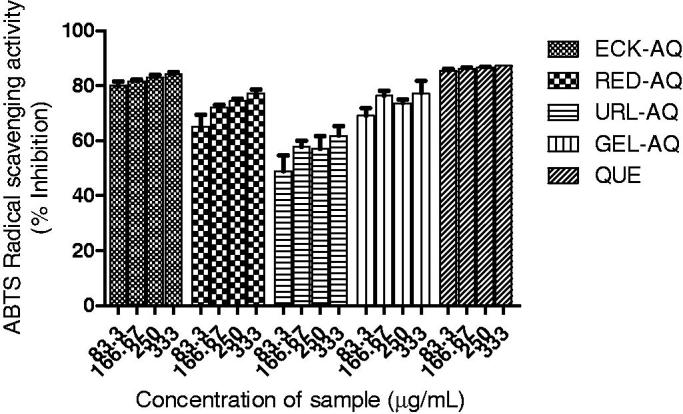
ABTS radical scavenging activities of seaweed extracts. QUE: quercetin.
Figure 3.
Radical scavenging and metal chelating activities of seaweed extracts. (A) DPPH radical scavenging ability (%). (B) OH radical scavenging ability (%). (C) Fe2+ chelating ability (%). QUE: Quercetin.
Table 5.
IC50 (µg/mL) of aqueous-ethanol extracts of some seaweeds.
| Extract | ECK-AQ | RED-AQ | URL-AQ | GEL-AQ | QUE | GAL |
|---|---|---|---|---|---|---|
| DPPH | 181.66 ± 0.36d | 186.71 ± 6.53d | 278.90 ± 4.51a | 153.22 ± 1.67e | 136.57 ± 1.22b | – |
| OH | 30.42 ± 0.68a | 41.23 ± 1.37c | 38.52 ± 0.98d | 33.70 ± 0.70b | 28.69 ± 0.79c | – |
| Fe-chelation | 280.47 ± 5.08c | 334.45 ± 6.53a | 320.92 ± 5.67b | 303.28 ± 2.39d | 279.66 ± 9.94c | |
| AChE | 49.41 ± 2.02a | 64.56 ± 1.17b | 56.60 ± 4.05c | 52.70 ± 1.85c | – | 37.84 ± 1.03d |
| BChE | 52.11 ± 2.82a | 63.03 ± 4.80d | 71.19 ± 2.92b | 58.28 ± 1.79c | – | 39.61 ± 1.08e |
Value represent mean ± standard deviation of replicates (n = 3). Values with different superscript letter along the same column are significantly different (p<.05). – Not determined. QUE: Quercetin; GAL: Galathanmine.
The chelating activity of the extracts against Fe2+ increased with increase in concentration. Moreover, ECK-AQ (280.47 µg/mL) exhibited the highest chelating activity followed by GEL-AQ (303.28 µg/mL), URL-AQ (320.92 µg/mL) and RED-AQ (334.45 µg/mL) (see Table 5).
Modulation of cholinesterase activities
The modulatory effect of the seaweed extracts on butyrylcholinesterase and acetylcholinesterase was also determined. Figure 4(A,B) show that the extracts reduced the activity of BChE and AChE, although higher inhibitory effects were observed on the latter compared to the former. At the highest concentration of the extracts, the highest BChE inhibitory activity was observed for ECK-AQ, GEL-AQ, URL-AQ and RED-AQ (Figure 4(A)). The IC50 values in Table 5 revealed that ECK-AQ (52.11 µg/mL) exhibited the highest inhibitory activity against BChE, while URL-AQ (71.19 µg/mL) showed the least. Similarly, the interaction of the seaweed extracts led to a significant decrease in AChE activity in vitro (Figure 4(B)). RED-AQ (64.56 µg/mL) exhibited significantly lower AChE inhibitory activity compared to ECK-AQ (49.41 µg/mL), GEL-AQ (52.70 µg/mL) and URL-AQ (56.60 µg/mL). Moreover, all the extracts showed potent inhibitory activity above 60% (Figure 4(B)). Galathanmine exhibited higher AChE and BChE inhibitory activities compared to the seaweed extracts.
Figure 4.
Cholinesterase inhibitory activities of seaweed extracts. (A) BChE inhibitory activity (%). (B) AChE inhibitory activity (%). GAL: Galanthamine.
Modulatory effects of seaweed extracts on Aβ1-42 aggregation
The modulatory effect of the seaweed extracts on Aβ1-42 was determined using electron microscope and thioflavin-T assay. The electron micrographs in Figure 5(A) revealed the formation of matured amyloid fibrils and aggregation of the protein in the control experiment after 48 h. Moreover, continuous aggregation of Aβ1-42 was observed after 72 and 96 h. ECK, RED-AQ, GEL-AQ and URL-AQ were incubated separately with Aβ1-42 for 96 h as shown in Figure 5(B–E), respectively. Figure 5(B–E) shows that the seaweed extracts reduced and/or inhibited formation of matured fibrils and prevented continuous aggregation of the protein after incubation for 48–96 h.
Figure 5.
Electron micrographs showing the effects of seaweed extracts (200 µg/mL) on formation of Aβ1-42 fibrils and aggregation at different intervals. (A) Control (Aβ1-42); (B) Aβ1-42 + ECK-AQ; (C) Aβ1-42 + RED-AQ; (D) Aβ1-42 + URL-AQ; (E): Aβ1-42 + GEL-AQ.
Disaggregation effects of seaweed extracts on matured Aβ1-42 fibrils
To measure the disaggregation effect of the seaweed extracts, Aβ1-42 (without the extracts) were incubated for 48 h to obtain protein aggregates and matured amyloid fibrils. The seaweed extracts were added separately to the matured fibrils after 48 h. Figure 6(A) revealed the formation of matured fibrils and further aggregation of the protein. However, disappearance of amyloid fibrils and disaggregation of the preformed and/or matured Aβ1-42 fibrils was observed after 72 and 96 h in Aβ1-42 treated with seaweed extracts as shown in Figure 6(B–E). Figure 7 shows the results obtained from thioflavin-T assay. The result revealed that fluorescence intensity of the control increased with increase in incubation time. However, after treatment with the seaweed extracts after incubation for 24 h, fluorescence intensity reduced significantly compared to the control.
Figure 6.
Electron micrographs showing the effects of seaweed extracts (200 µg/mL) on disaggregation of preformed Aβ1-42 at different intervals. (A) Control (Aβ1-42); (B) Aβ1-42 + ECK-AQ; (C) Aβ1-42 + RED-AQ; (D) Aβ1-42 + URL-AQ; (E): Aβ1-42 + GEL-AQ. The seaweed extracts were added to Aβ1-42 after 48 h.
Figure 7.
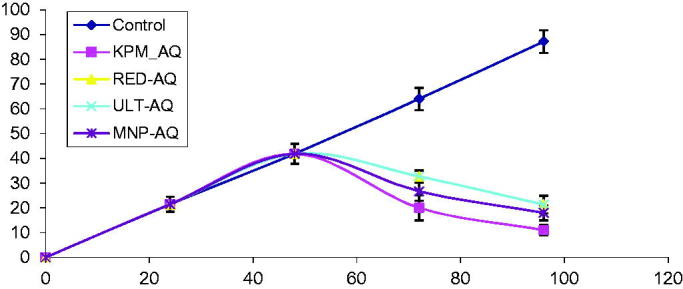
Thioflavin-T fluorescence intensity showing effects of seaweed extracts (200 µg/mL) on disaggregation of Aβ1-42 at different intervals. Treatment with the seaweed extracts occurred at 48 h.
Discussion
One of the pathological hallmarks of AD involves damage to the neurons which impairs neurotransmission and cognitive function. Free radical-induced neuronal damage is an important mechanism in the progression of AD (Zhao and Zhao 2013). The brain is susceptible to free radical attack due to low antioxidant mechanism; hence, overproduction of reactive oxygen species may cause oxidative stress-induced neuronal damage (Oboh et al. 2013). Our findings revealed that aqueous extracts from the selected seaweeds scavenged ABTS, DPPH and OH radicals and were able to chelate Fe2+. The observed scavenging and chelating activities suggest the antioxidant potentials of ECK-AQ, RED-AQ, URL-AQ and GEL-AQ. The antioxidant potentials of the seaweed extracts may prevent oxidative damage to neurons and improve neuronal dysfunction or neurodegeneration associated with redox imbalance. The antioxidant activities of the seaweed extracts may be linked to their bioactive constituents. Phloroglucinol, quercetin, catechin, epicatechin-3 glucoside, 3,5,7-dimethoxyflavone and biochanin A that were present in the extracts are potent antioxidants and may contribute to the observed radical and metal-chelating activities due to their ability to donate hydrogen and abstract electron (Paganga et al. 1996; Quéguineur et al. 2012; Tatsimo et al. 2012; Viau et al. 2016).
Cholinergic enzymes are very important in neurotransmission and regulate processes involved in cognitive function (Ferreira-Vieira et al. 2016). Loss of memory in AD cases has been attributed to disruption of cholinergic function via increased AChE and BChE activities as well as low levels of acetylcholine (Olasehinde et al. 2017). In this study, we evaluated the effects of some seaweed extracts on cholinesterases. Our results revealed that ECK-AQ, RED-AQ, URL-AQ and GEL-AQ inhibited acetylcholinesterase activity which is consistent with the report of Shanmuganathan and Devi (2016). Similarly, the seaweed extracts exhibited inhibitory effect on butyrylcholinesterase activities. A decrease in acetylcholinesterase and butyrylcholinesterase activities has been shown as an effective strategy to mitigate cholinergic deficit in AD (Lane et al. 2006; Oboh, Adewuni, et al. 2018). Hence, the inhibitory effects of these seaweed extracts on the cholinergic enzymes may improve cholinergic function. Our findings reveal that the extracts showed higher inhibitory effect on acetylcholinesterase compared to butyrylcholinesterase. Moreover, the active constituents of the extracts may influence their enzyme inhibitory properties. Burmaoglu et al. (2018) reported that some phloroglucinol derivatives showed potent inhibitory effect on BChE and AChE. Furthermore, the synergistic effects of other compounds (quercetin, catechin, epicatechin-3-glucoside) present in the extracts may also contribute to the observed decrease in BChE and AChE activities as their inhibitory effects on these cholinergic enzymes have been reported (Lane et al. 2004; Biradar et al. 2014; Suganthy and Devi 2016; Olasehinde, Olaniran, et al. 2019).
High cholinesterase activity in AD has been linked with the formation of neurotoxic amyloid plaques (Mushtaq et al. 2014). Carvajal and Inestrosa (2011) reported that AChE promotes the production of Aβ thereby forming complexes with the protein fibrils. Previous reports have also shown that BChE contributes to the formation Aβ plaques and neurofibrillary tangles in the neocortical region of the brain (Perry et al. 1978; Mushtaq et al. 2014). Matured Aβ fibrils form clogs around the neurons, hinder interactions between brain cells and alter cerebral brain functions (Shanmuganathan et al. 2018). Furthermore, continuous aggregation of Aβ protein leads to the formation of plaques, neuro-inflammation, neurodegeneration, cognitive dysfunction and ultimately memory loss (Mokhtar et al. 2013; Heneka et al. 2015). Recent research has been on finding natural compounds capable of inhibiting the aggregation of Aβ fibrils in Alzheimer’s disease model. Our findings revealed that ECK-AQ, RED-AQ, URL-AQ and GEL-AQ were able to inhibit fibrillogenesis and suppressed continuous aggregation of matured amyloid fibrils in a two-phase experiment. In the first phase, the seaweeds showed potent inhibition of formation and/or aggregation of Aβ1-42 fibrils. While Aβ1-42 fibrils and aggregates were formed in the control experiment, a reduction in the fibrils was observed after co-treatment with the seaweed extracts. However, more Aβ1-42 aggregates were observed in RED-AQ and URL-AQ incubated with Aβ1-42 after 48 h compared to ECK-AQ and GEL-AQ. Similar results were obtained after 72 and 96 h. Aggregation of Aβ1-42 was inhibited after co-treatment with the seaweed extracts as shown by the smaller fragments of peptides and/or fibrils. Larger amount of aggregates was observed after co-treatment with RED-AQ and GEL-AQ but lesser than the control. This suggests that ECK-AQ and GEL-AQ may exhibit better inhibitory effect on Aβ1-42 formation and aggregation compared to RED-AQ and URL-AQ. These findings correlate with the reports of Shanmuganathan et al. (2015) and Syad and Devi (2015) which revealed that Gelidiella acerosa (Forsskal) Feldmann et Hamel (Gelidiellaceae) and Padino gymnospora (Kutzing) Sonder (Dictyotaceae) extracts prevented aggregation of Aβ25-35, respectively. Furthermore, phloroglucinol, catechin and quercetin have been reported to inhibit β-amyloid aggregation (Vauzour 2012; Shanmuganathan et al. 2015; Yang et al. 2018). These compounds were detected in the seaweed extracts used in this study and may contribute to their anti-amyloidogenic activities.
In the second phase of the experiment, continuous aggregation of Aβ1-42 was observed in the control at different time intervals. Aggregation of the protein increased with time as shown in the control. However co-treatment with the extracts after 48 h led to disaggregation of the preformed and matured fibrils. The decrease in protein aggregates observed after the treatment suggests the disaggregation of Aβ1-42 aggregates. Better disaggregation effect of Aβ1-42 aggregates was exhibited by ECK-AQ and GEL-AQ compared to URL-AQ and RED-AQ. Furthermore, thioflavin assay was used in this study to quantify the levels of amyloid fibril. Thioflavin is an important quantitative marker of β-amyloid protein. Mostly, fluorescence intensity increases rapidly when thioflavin binds to amyloid fibrils. An increase in fluorescence intensity was observed in the control. Co-treatment with the seaweed extracts caused a decrease in fluorescence intensity. The observed decrease in fluorescence intensity with increase in incubation time which was exhibited by ECK-AQ, GEL-AQ, ULT and RED-AQ suggests loss or low levels of matured amyloid fibrils. This result correlates with the decrease in protein aggregates observed in the electron micrographs. The electron micrographs revealed that the extracts disassembled preformed aggregates and/or matured amyloid fibrils after 72 h. Our findings revealed that the constituents of the extracts may contribute to the inhibition of aggregation and disaggregation of Aβ1-42 fibrils.
Conclusion
This study reveals the phenolic composition, antioxidant, cholinesterase inhibitory and anti-amyloidogenic activities of aqueous extracts of G. beckeri, G. pristoides, U. rigida and E. maxima, via their radical scavenging and metal-chelating activities, acetylcholinesterase and butyrylcholinesterase activities, as well as inhibition of Aβ1-42 aggregation and disaggregation of matured amyloid fibrils. Phloroglucinol, catechin, epicatechin-3 glucoside, quercetin, kaempferol and 3,5,7-trimethoxy flavone were present in the extracts. Our findings suggest potential neuroprotective effects of these extracts which could be linked to the presence of some phenolic compounds. Hence, these seaweeds may be good sources of antioxidants, cholinesterase and β-amyloid aggregation inhibitors and could be explored as an alternative therapeutic strategy for the management of AD.
Funding Statement
This work is supported by National Research Foundation of South Africa, The World Academy of Science and South African Medical Research Council.
Disclosure statement
The authors declare no conflict of interest.
References
- Adefegha SA, Oboh G, Olasehinde TA. 2016. Alkaloid extracts from shea butter and breadfruit as potential inhibitors of monoamine oxidase, cholinesterases, and lipid peroxidation in rats’ brain homogenates: a comparative study. Comp Clin Pathol. 25:1213–1219. [Google Scholar]
- Admassu H, Gasmalla MA, Yang R, Zhao W. 2018. Bioactive peptides derived from seaweed protein and their health benefits: antihypertensive, antioxidant, and antidiabetic properties. J Food Sci. 83:6–16. [DOI] [PubMed] [Google Scholar]
- Biradar SM, Joshi H, Chheda TK. 2014. Biochanin-A ameliorates behavioural and neurochemical derangements in cognitive-deficit mice for the betterment of Alzheimer’s disease. Human Exp Tox. 33:369–382. [DOI] [PubMed] [Google Scholar]
- Bixler HJ, Porse H. 2011. A decade of change in the seaweed hydrocolloids industry. J Appl Phycol. 23:321–335. [Google Scholar]
- Burmaoglu S, Yilmaz AO, Taslimi P, Algul O, Kilic D, Gulcin I. 2018. Synthesis and biological evaluation of phloroglucinol derivatives possessing α‐glycosidase, acetylcholinesterase, butyrylcholinesterase, carbonic anhydrase inhibitory activity. Archiv Der Pharmaziepharm Life. 351:1700314. [DOI] [PubMed] [Google Scholar]
- Carvajal FJ, Inestrosa NC. 2011. Interactions of AChE with Aβ aggregates in Alzheimer’s brain: therapeutic relevance of IDN 5706. Front Mol Neurosc. 4:1–26. [DOI] [PMC free article] [PubMed] [Google Scholar]
- Cheignon C, Tomas M, Bonnefont-Rousselot D, Faller P, Hureau C, Collin F. 2018. Oxidative stress and the amyloid beta peptide in Alzheimer’s disease. Redox Bio. 14:450–464. [DOI] [PMC free article] [PubMed] [Google Scholar]
- Feng Y, Wang X. 2012. Antioxidant therapies for Alzheimer's disease. Oxid Med Cell Long. 2012:472932. [DOI] [PMC free article] [PubMed] [Google Scholar]
- Ferreira-Vieira T, Guimaraes M, Silva RL, Ribeiro F. 2016. Alzheimer's disease: targeting the cholinergic system. Curr Neuropharm. 14:101–115. [DOI] [PMC free article] [PubMed] [Google Scholar]
- Gyamfi MA, Yonamine M, Aniya Y. 1999. Free radical scavenging action of medicinal herbs from Ghana: Thonningia sanguinea on experimentally induced liver injuries. Gen Pharm. 32:661–667. [DOI] [PubMed] [Google Scholar]
- Halliwell B, Gutteridge J. 1981. Formation of thiobarbituric-acid-reactive substance from deoxyribose in the presence of iron salts: The role of superoxide and hydroxyl radicals. FEBS Lett. 128:347–352. [DOI] [PubMed] [Google Scholar]
- Heneka MT, Carson MJ, El Khoury J, Landreth GE, Brosseron F, Feinstein DL, Jacobs AH, Wyss-Coray T, Vitorica J, Ransohoff RM, et al. . 2015. Neuroinflammation in Alzheimer's disease. The Lancet Neurol. 14:388–405. [DOI] [PMC free article] [PubMed] [Google Scholar]
- Kalinski JC, Waterworth S, Siwe NX, Jiwaji M, Parker-Nance S, Krause R, McPhail K, Dorrington R. 2019. Molecular networking reveals two distinct chemotypes in pyrroloiminoquinone-producing Tsitsikamma favus sponges. Mar Drugs. 17:1–16. [DOI] [PMC free article] [PubMed] [Google Scholar]
- Khalid S, Abbas M, Saeed F, Bader-Ul-Ain H, Suleria HAR. 2018. Therapeutic potential of seaweed bioactive compounds. Seaweed Biomaterials. Sabyasachi Maiti, IntechOpen. [accessed 2019 April 15]. https://www.intechopen.com/books/seaweed-biomaterials/therapeutic-potential-of-seaweed-bioactive-compounds.
- Lane RM, Kivipelto M, Greig NH. 2004. Acetylcholinesterase and its inhibition in Alzheimer disease. Clinical Neuropharm. 27:141–149. [DOI] [PubMed] [Google Scholar]
- Lane RM, Potkin SG, Enz A. 2006. Targeting acetylcholinesterase and butyrylcholinesterase in dementia. Int J Neuropsychopharmacol. 9:101–124. [DOI] [PubMed] [Google Scholar]
- Li K, Wei S, Liu Z, Hu L, Lin J, Tan S, Mai Y, Peng W, Mai H, Hou Q, et al. . 2018. The prevalence of Alzheimer's disease in China: a systematic review and meta-analysis. Iranian J Public Health. 47:1615–1626. [PMC free article] [PubMed] [Google Scholar]
- Lordan S, Ross RP, Stanton C. 2011. Marine bioactives as functional food ingredients: potential to reduce the incidence of chronic diseases. Marine Drugs. 9:1056–1100. [DOI] [PMC free article] [PubMed] [Google Scholar]
- Mendiola-Precoma J, Berumen LC, Padilla K, Garcia-Alcocer G. 2016. Therapies for prevention and treatment of Alzheimer’s disease. BioMed Research Int. 2016:2589276. [DOI] [PMC free article] [PubMed] [Google Scholar]
- Mohamed S, Hashim SN, Rahman HA. 2012. Seaweeds: a sustainable functional food for complementary and alternative therapy. Trends in Food Sci Tech. 23:83–96. [Google Scholar]
- Mokhtar SH, Bakhuraysah MM, Cram DS, Petratos S. 2013. The beta-amyloid protein of Alzheimer’s disease: communication breakdown by modifying the neuronal cytoskeleton. Int J Alzheimer’s Dis. 2013:910502. [DOI] [PMC free article] [PubMed] [Google Scholar]
- Mushtaq G, Greig H, Khan NA, Kamal JM. 2014. Status of acetylcholinesterase and butyrylcholinesterase in Alzheimer's disease and type 2 diabetes mellitus. CNS Neurol Disorders-Drug Targets. 13:1432–1439. [DOI] [PMC free article] [PubMed] [Google Scholar]
- Oboh G, Ademosun AO, Ogunsuyi OB, Oyedola ET, Olasehinde TA, Oyeleye SI. 2018a. In vitro anticholinesterase, antimonoamine oxidase and antioxidant properties of alkaloid extracts from kola nuts (Cola acuminata and Cola nitida ). J Comp Int Med. 16 [accessed 2019 Apr 15]. 10.1515/jcim-2016-0155. [DOI] [PubMed] [Google Scholar]
- Oboh G, Adewuni TM, Ademiluyi AO, Olasehinde TA, Ademosun AO. 2018b. Phenolic constituents and inhibitory effects of Hibiscus sabdariffa L. (Sorrel) calyx on cholinergic, monoaminergic, and purinergic enzyme activities. J Dietary Suppl. 15:910–922. [DOI] [PubMed] [Google Scholar]
- Oboh G, Agunloye OM, Akinyemi AJ, Ademiluyi AO, Adefegha SA. 2013. Comparative study on the inhibitory effect of caffeic and chlorogenic acids on key enzymes linked to Alzheimer’s disease and some pro-oxidant induced oxidative stress in rats’ brain-in vitro . Neurochemical Res. 38:413–419. [DOI] [PubMed] [Google Scholar]
- O'Brien RJ, Wong PC. 2011. Amyloid precursor protein processing and Alzheimer's disease. Annu Rev Neurosci. 34:185–204. [DOI] [PMC free article] [PubMed] [Google Scholar]
- Olasehinde TA, Mabinya LV, Olaniran AA, Okoh AI. 2019. Chemical characterization, antioxidant properties, cholinesterase inhibitory and anti-amyloidogenic activities of sulfated polysaccharides from some seaweeds. Bioact Carb Dietary Fibre. 18:100182 [accessed 2019 May 20]. 10.1016/j.bcdf.2019.100182. [DOI] [Google Scholar]
- Olasehinde TA, Odjadjare EC, Mabinya LV, Olaniran AO, Okoh AI. 2019. Chlorella sorokiniana and Chlorella minutissima exhibit antioxidant potentials, inhibit cholinesterases and modulate disaggregation of β-amyloid fibrils. Electronic J Biotech. 40:1–9. [Google Scholar]
- Olasehinde TA, Olaniran AO, Okoh A. 2017. Therapeutic potentials of microalgae in the treatment of Alzheimer’s disease. Molecules. 22:480–418. [DOI] [PMC free article] [PubMed] [Google Scholar]
- Olasehinde TA, Olaniran AO, Okoh AI. 2019. Aqueous–ethanol extracts of some South African seaweeds inhibit β‐amyloid aggregation, cholinesterases, and β‐secretase activities in vitro . J Food Biochem. e12870 [accessed 2019 May 15]. 10.1111/jfbc.12870. [DOI] [PubMed] [Google Scholar]
- Paganga G, Al-Hashim H, Khodr H, Scott BC, Aruoma OI, Hider RC, Halliwell B, Rice-Evans CA. 1996. Mechanisms of antioxidant activities of quercetin and catechin. Redox Rep: Commun Free Radical Res. 2:359–364. [DOI] [PubMed] [Google Scholar]
- Perry EK, Perry RH, Blessed G, Tomlinson BE. 1978. Changes in brain cholinesterases in senile dementia of Alzheimer type. Neuropathol Appl Neurobiol. 4:273–277. [DOI] [PubMed] [Google Scholar]
- Perry NS, Houghton PJ, Theobald A, Jenner P, Perry EK. 2000. In vitro activity of Slavandula efolia (Spanish sage) relevant to treatment of Alzheimer’s disease. J Pharm Pharm. 52:895–902. [DOI] [PubMed] [Google Scholar]
- Plaza M, Cifuentes A, Ibáñez E. 2008. In the search of new functional food ingredients from algae. Trends Food Sci Tech. 19:31–39. [Google Scholar]
- Puntel RL, Nogueira CW, Rocha J. 2005. Krebs cycle intermediates modulate thiobarbituric acid reactive species (TBARS) production in rat brain in vitro . Neurochem Res. 30:225–235. [DOI] [PubMed] [Google Scholar]
- Quéguineur B, Goya L, Ramos S, Martín MA, Mateos R, Bravo L. 2012. Phloroglucinol: Antioxidant properties and effects on cellular oxidative markers in human HepG2 cell line. Food Chem Tox. 50:2886–2893. [DOI] [PubMed] [Google Scholar]
- Re R, Pellegrini N, Proteggente A, Pannala A, Yang M, Rice-Evans C. 1999. Antioxidant activity applying an improved ABTS radical cation decolorization assay. Free Radic Biol Med. 26:1231–1237. [DOI] [PubMed] [Google Scholar]
- Rosensweig C, Ono K, Murakami K, Lowenstein DK, Bitan G, Teplow DB. 2012. Preparation of stable amyloid β-protein oligomers of defined assembly order In: Sigurdsson E, Calero M, Gasset M, editors. Amyloid proteins. Methods in molecular biology (Methods and Protocols). New York: Humana Press; p. 23–31. [DOI] [PMC free article] [PubMed] [Google Scholar]
- Shanmuganathan B, Malar DS, Sathya S, Devi KP. 2015. Antiaggregation potential of Padina gymnospora against the toxic Alzheimer’s β-amyloid peptide 25-35 and cholinesterase inhibitory property of its bioactive compounds. PloS One. 10:e0141708–14. [DOI] [PMC free article] [PubMed] [Google Scholar]
- Shanmuganathan B, Pandima Devi K. 2016. Evaluation of the nutritional profile and antioxidant and anti-cholinesterase activities of Padina gymnospora (Phaeophyceae). European Journal of Phycology. 51(4):482–490. [Google Scholar]
- Shanmuganathan B, Suryanarayanan V, Sathya S, Narenkumar M, Singh SK, Ruckmani K, Devi KP. 2018. Anti-amyloidogenic and anti-apoptotic effect of α-bisabolol against Aβ induced neurotoxicity in PC12 cells. European J Med Chem. 143:1196–1207. [DOI] [PubMed] [Google Scholar]
- Singh SK, Srivastav S, Yadav AK, Srikrishna S, Perry G. 2016. Overview of Alzheimer’s disease and some therapeutic approaches targeting Aβ by using several synthetic and herbal compounds. Oxid Med Cell Long. 2016:7361613. [DOI] [PMC free article] [PubMed] [Google Scholar]
- Suganthy N, Devi PK. 2016. In vitro antioxidant and anti-cholinesterase activities of Rhizophora mucronata . Pharm Biol. 54:118–129. [DOI] [PubMed] [Google Scholar]
- Syad AN, Devi KP. 2015. Assessment of anti-amyloidogenic activity of marine red alga G. acerosa against Alzheimer’s β-amyloid peptide 25-35. Neurol Res. 37:14–22. [DOI] [PubMed] [Google Scholar]
- Tatsimo SJN, de Dieu Tamokou J, Havyarimana L, Csupor D, Forgo P, Hohmann J, Kuiate JR, Tane P. 2012. Antimicrobial and antioxidant activity of kaempferol rhamnoside derivatives from Bryophyllum pinnatum . BMC Res Notes. 5:1–6. [DOI] [PMC free article] [PubMed] [Google Scholar]
- Vauzour D. 2012. Dietary polyphenols as modulators of brain functions: biological actions and molecular mechanisms underpinning their beneficial effects. Oxid Med Cell Longev. 2012:914273. [DOI] [PMC free article] [PubMed] [Google Scholar]
- Viau CM, Moura DJ, Pflüger P, Facundo VA, Saffi J. 2016. Structural aspects of antioxidant and genotoxic activities of two flavonoids obtained from ethanolic extract of Combretum leprosum . Evidence-Based Comp Alt Med. 2016:9849134. [DOI] [PMC free article] [PubMed] [Google Scholar]
- Yang EJ, Mahmood U, Kim H, Choi M, Choi Y, Lee JP, Cho JY, Hyun JW, Kim YS, Chang MJ, et al. . 2018. Phloroglucinol ameliorates cognitive impairments by reducing the amyloid β peptide burden and pro-inflammatory cytokines in the hippocampus of 5XFAD mice. Free Radic Biol Med. 126:221–234. [DOI] [PubMed] [Google Scholar]
- Zhao Y, Zhao B. 2013. Oxidative stress and the pathogenesis of Alzheimer's disease. Oxidative. Med Cell Longev. 2013:316523. [DOI] [PMC free article] [PubMed] [Google Scholar]



